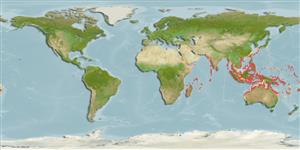>
Pleuronectiformes (Flatfishes) >
Bothidae (Lefteye flounders)
Etymology: Asterorhombus: Greek, aster = star + Greek, rhombos = paralelogram (Ref. 45335); cocosensis: Named for its type locality, Cocos Island (Ref. 57759).
More on author: Bleeker.
Environment: milieu / climate zone / depth range / distribution range
Sinh thái học
Biển gần đáy; Mức độ sâu 1 - 30 m (Ref. 57759). Tropical
Indo-West Pacific: Mozambique to Fiji; north to Japan, south to Queensland, Australia (not occurring nonmarginally on the Pacific Plate).
Bộ gần gũi / Khối lượng (Trọng lượng) / Age
Maturity: Lm ? range ? - ? cm
Max length : 12.0 cm SL con đực/không giới tính; (Ref. 57759)
Các vây lưng mềm (tổng cộng): 79-83; Tia mềm vây hậu môn: 59 - 64; Động vật có xương sống: 35 - 36. This species is characterized by the following: body depth 51.5-58.3; sexual dimorphism
in interorbital width, in specimens approximately 6.0 cm SL, males 4.1-7.9, females 3.2-5.0; first dorsal-fin ray isometric relative to SL, with distinct membranous structure confined to tip. Pectoral fin count at the ocular side 10-13, blind side 8-11. The membranous structure at the tip of the first dorsal fin resembles a small fish or crustacean (possibly a small hippolytid shrimp), authors called the ray the illicium and the structure at the tip as the esca (Ref. 57759).
Found on pale sandy substrates in clearwater coastal bays to outer reef lagoons and sandy gutters on reef flats. Often crawls over low stony reef (Ref. 48637). The membranous structure at the tip of the first dorsal fin resembles a small fish or crustacean (possibly a small hippolytid shrimp), authors called the ray the illicium and the structure at the tip as the esca. The illicium waves the esca back and forth near mouth to attract prey. Shows sexual dimorphism in width of the interorbital origin, wider in males than females. Most frequently collected by divers.
Life cycle and mating behavior
Chín muồi sinh dục | Sự tái sinh sản | Đẻ trứng | Các trứng | Sự sinh sản | Ấu trùng
Hensley, D.A., 2005. Revision of the genus Asterorhombus (Pleuronectiformes: Bothidae). Copeia 2005(3):445-460. (Ref. 57759)
IUCN Red List Status (Ref. 130435)
Threat to humans
Harmless
Human uses
Thêm thông tin
Các tài liệu tham khảoNuôi trồng thủy sảnTổng quan nuôi trồng thủy sảnCác giốngDi truyềnElectrophoresesDi sảnCác bệnhChế biếnNutrientsMass conversion
Các công cụ
Special reports
Download XML
Các nguồn internet
Estimates based on models
Preferred temperature (Ref.
123201): 24.8 - 29.3, mean 28.4 °C (based on 3223 cells).
Phylogenetic diversity index (Ref.
82804): PD
50 = 0.6250 [Uniqueness, from 0.5 = low to 2.0 = high].
Bayesian length-weight: a=0.00912 (0.00408 - 0.02036), b=3.05 (2.87 - 3.23), in cm total length, based on LWR estimates for this (Sub)family-body shape (Ref.
93245).
Mức dinh dưỡng (Ref.
69278): 3.6 ±0.59 se; based on food items.
Thích nghi nhanh (Ref.
120179): Trung bình, thời gian nhân đôi của chủng quần tối thiểu là 1.4 - 4.4 năm (Preliminary K or Fecundity.).
Fishing Vulnerability (Ref.
59153): Low vulnerability (10 of 100).
